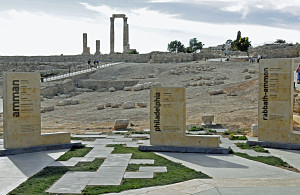Citadel Hill, the highest of Amman’s seven hills, includes evidence of human occupation since 7,000 B.C., making it one of the world’s longest continuously inhabited sites. At the time of Israel’s King David, a hill-top citadel defended an Ammonite city called Rabbath-Ammon. According to the Bible, Uriah the Hittite was among the Israelite troops besieging the fortress when David, remaining behind in Jerusalem, seduced Uriah’s wife, the beautiful Bathsheba. David then ordered Uriah to the front lines where, as David had hoped, an archer perched on the citadel wall killed Uriah with an arrow. David took Bathsheba as his wife and, after belatedly joining the battle, captured Rabbath-Ammon to join the previously-captured Kingdom of Moab on the eastern edge of his United Monarchy.
After the United Monarchy collapsed upon the death of Solomon, David’s son with Bathsheba, Rabbath-Ammon fell under control of a parade of empires, starting with Assyria, Babylon and then Persia. The Greeks captured Rabbath-Ammon from the Persians in the third century B.C., renamed it Philadelphia and lost it to the Nabateans. On behalf of Rome, Herod the Great captured Philadelphia from the Nabateans in 30 B.C. and made it one of the cities of the Decapolis. The Romans later built a large temple to Hercules atop Citadel Hill. After Christianity became legal in the Roman Empire, Philadelphia became the seat of a bishop and residents destroyed the temple and used its columns in their basilica. When Muslims conquered the city, they renamed it Amman and built a still-standing palace over another church, with a mosque nearby.
Citadel Hill contains two millennia worth of temples, churches and mosques. The Jordan Archaeological Museum on the hill displays a reproduction of a stele chronicling how King Mesha recaptured Moab after the fall of the United Monarchy. There is a lot of history on Citadel Hill.

Comments are closed.